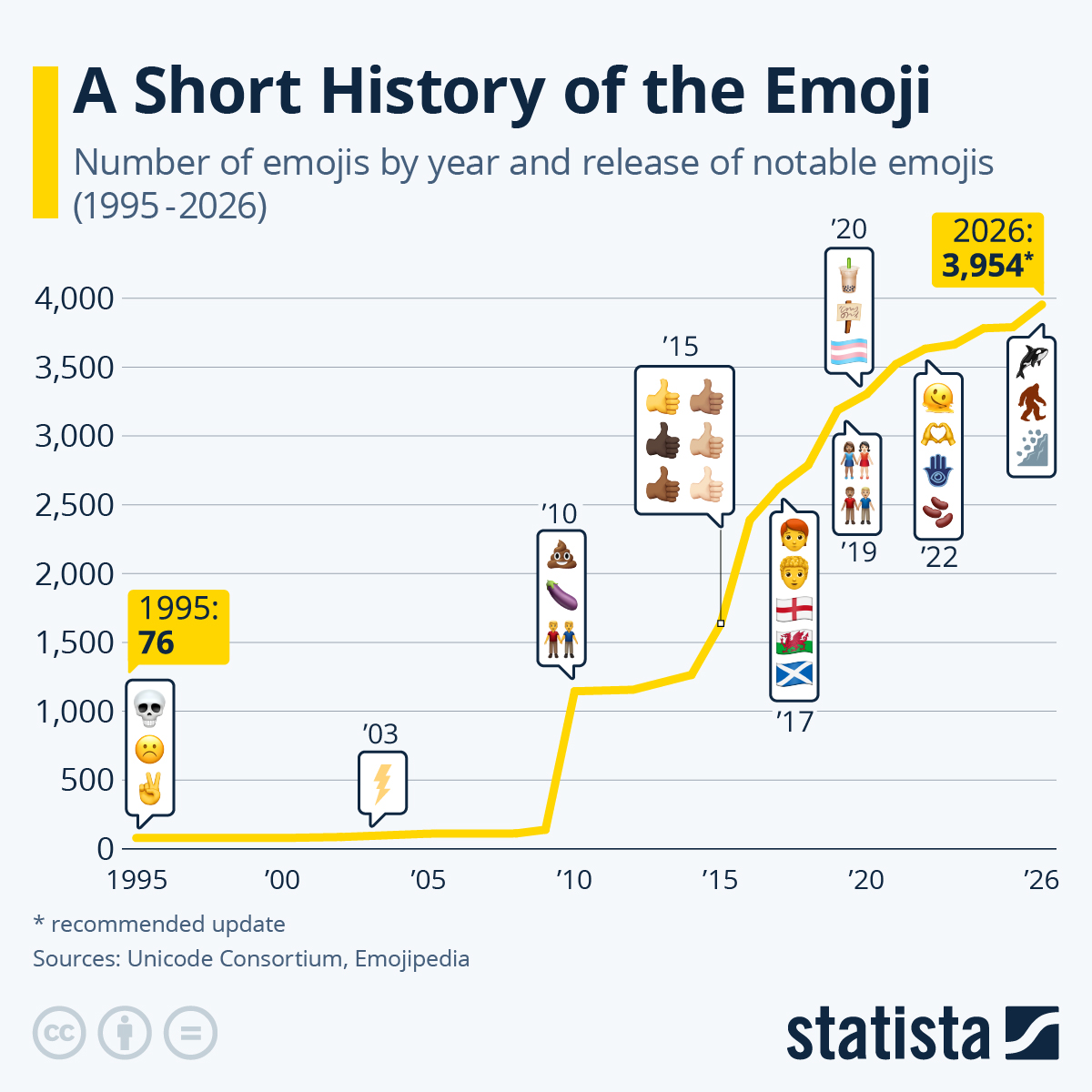A Short History Of The Emoji
Emojis have become a staple of electronic communication since their inception in the 1990s and people of all ages and on all continents use them. While their number keeps on growing every year due to new releases by the Unicode Consortium, the pictograms are increasingly vying for users’ attention as other forms of visual communication – think gifs, stickers and avatars – are experiencing their heyday.
With myriads of emojis released over the previous years, new batches have become somewhat smaller.
As Statista’s Katharina Buchholz reports, a recently suggested update that would grow the number of emojis to almost 4,000 next year contains 164 additional pictograms, but only nine completely new ones.
While 2022 had seen the release of 112 new emojis, that number was just 31 in 2023. The figure rose again to 118 in 2024 due to emojis that allow users to pick different skin colors or genders (which are counted individually), before falling to an all-time low of eight in 2025. The number of non-customizable emojis has meanwhile decreased with almost every release.
You will find more infographics at Statista
New 2025 icons included the beetroot, the shovel and the flag of British Channel Island Sark – showing how emoji makers are seemingly running out of ideas (despite taking submissions from the public). The Unicode Consortium has recommended the orca, the yeti, the landslide and the ballet dancer, among others, for release in 2026, but the final decision is still outstanding.
What emojis appear on people’s phones and on their social media platforms is not arbitrary but has been coordinated by the Unicode Consortium since 1995, when the first 76 pictograms were adapted by the U.S. nonprofit. The Consortium has been overseeing the character inventory of electronic text processing since 1991 and sets a standard for symbols, characters in different scripts and – last but not least – emojis, which are encoded uniformly across different platforms even though illustration styles may vary between providers.
Despite the first Unicode listings predating them, a 1999 set of 176 simple pictograms invented by interface designer Shigetaka Kurita for a Japanese phone operator is considered to be the precursor of modern-day emojis. The concept gained popularity in Japan and by 2010, Unicode rolled out a massive release of more than 1,000 emojis to get with the burgeoning trend – the rest is history.
Different skin colors have been available for emojis since 2015. The first regional flags came to the service in 2017. The first same-sex couples have been available since the major emoji release of 2010, but more versions were added in 2015. The 2017 release also included the rollout of the first non-binary options, while interracial couples first appeared in 2019.
Tyler Durden Thu, 07/17/2025 – 18:10
Source: https://freedombunker.com/2025/07/17/a-short-history-of-the-emoji/
Anyone can join.
Anyone can contribute.
Anyone can become informed about their world.
"United We Stand" Click Here To Create Your Personal Citizen Journalist Account Today, Be Sure To Invite Your Friends.
Before It’s News® is a community of individuals who report on what’s going on around them, from all around the world. Anyone can join. Anyone can contribute. Anyone can become informed about their world. "United We Stand" Click Here To Create Your Personal Citizen Journalist Account Today, Be Sure To Invite Your Friends.
LION'S MANE PRODUCT
Try Our Lion’s Mane WHOLE MIND Nootropic Blend 60 Capsules
Mushrooms are having a moment. One fabulous fungus in particular, lion’s mane, may help improve memory, depression and anxiety symptoms. They are also an excellent source of nutrients that show promise as a therapy for dementia, and other neurodegenerative diseases. If you’re living with anxiety or depression, you may be curious about all the therapy options out there — including the natural ones.Our Lion’s Mane WHOLE MIND Nootropic Blend has been formulated to utilize the potency of Lion’s mane but also include the benefits of four other Highly Beneficial Mushrooms. Synergistically, they work together to Build your health through improving cognitive function and immunity regardless of your age. Our Nootropic not only improves your Cognitive Function and Activates your Immune System, but it benefits growth of Essential Gut Flora, further enhancing your Vitality.
Our Formula includes: Lion’s Mane Mushrooms which Increase Brain Power through nerve growth, lessen anxiety, reduce depression, and improve concentration. Its an excellent adaptogen, promotes sleep and improves immunity. Shiitake Mushrooms which Fight cancer cells and infectious disease, boost the immune system, promotes brain function, and serves as a source of B vitamins. Maitake Mushrooms which regulate blood sugar levels of diabetics, reduce hypertension and boosts the immune system. Reishi Mushrooms which Fight inflammation, liver disease, fatigue, tumor growth and cancer. They Improve skin disorders and soothes digestive problems, stomach ulcers and leaky gut syndrome. Chaga Mushrooms which have anti-aging effects, boost immune function, improve stamina and athletic performance, even act as a natural aphrodisiac, fighting diabetes and improving liver function. Try Our Lion’s Mane WHOLE MIND Nootropic Blend 60 Capsules Today. Be 100% Satisfied or Receive a Full Money Back Guarantee. Order Yours Today by Following This Link.







